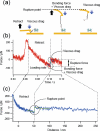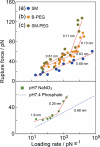Reconsideration of dynamic force spectroscopy analysis of streptavidin-biotin interactions
- PMID: 20559507
- PMCID: PMC2885099
- DOI: 10.3390/ijms11052134
Reconsideration of dynamic force spectroscopy analysis of streptavidin-biotin interactions
Abstract
To understand and design molecular functions on the basis of molecular recognition processes, the microscopic probing of the energy landscapes of individual interactions in a molecular complex and their dependence on the surrounding conditions is of great importance. Dynamic force spectroscopy (DFS) is a technique that enables us to study the interaction between molecules at the single-molecule level. However, the obtained results differ among previous studies, which is considered to be caused by the differences in the measurement conditions. We have developed an atomic force microscopy technique that enables the precise analysis of molecular interactions on the basis of DFS. After verifying the performance of this technique, we carried out measurements to determine the landscapes of streptavidin-biotin interactions. The obtained results showed good agreement with theoretical predictions. Lifetimes were also well analyzed. Using a combination of cross-linkers and the atomic force microscope that we developed, site-selective measurement was carried out, and the steps involved in bonding due to microscopic interactions are discussed using the results obtained by site-selective analysis.
Keywords: atomic force microscopy; dynamic force spectroscopy; site-selective analysis; streptavidin-biotin interaction.
Figures












Similar articles
-
Force measurement enabling precise analysis by dynamic force spectroscopy.Int J Mol Sci. 2012;13(1):453-65. doi: 10.3390/ijms13010453. Epub 2011 Dec 29. Int J Mol Sci. 2012. PMID: 22312263 Free PMC article.
-
Low cost and massively parallel force spectroscopy with fluid loading on a chip.Nat Commun. 2022 Nov 10;13(1):6800. doi: 10.1038/s41467-022-34212-w. Nat Commun. 2022. PMID: 36357383 Free PMC article.
-
Hidden variety of biotin-streptavidin/avidin local interactions revealed by site-selective dynamic force spectroscopy.Phys Chem Chem Phys. 2010 Oct 21;12(39):12578-83. doi: 10.1039/c0cp00259c. Epub 2010 Aug 20. Phys Chem Chem Phys. 2010. PMID: 20725689
-
Molecular recognition imaging and force spectroscopy of single biomolecules.Acc Chem Res. 2006 Jan;39(1):29-36. doi: 10.1021/ar050084m. Acc Chem Res. 2006. PMID: 16411737 Review.
-
Atomic force microscopy and force spectroscopy on the assessment of protein folding and functionality.Arch Biochem Biophys. 2013 Mar;531(1-2):116-27. doi: 10.1016/j.abb.2012.11.007. Epub 2012 Dec 7. Arch Biochem Biophys. 2013. PMID: 23228596 Review.
Cited by
-
Surface charge density measurement of a single protein molecule with a controlled orientation by AFM.Biophys J. 2021 Jun 15;120(12):2490-2497. doi: 10.1016/j.bpj.2021.04.016. Epub 2021 Apr 24. Biophys J. 2021. PMID: 33901471 Free PMC article.
-
Direction Matters: Monovalent Streptavidin/Biotin Complex under Load.Nano Lett. 2019 Jun 12;19(6):3415-3421. doi: 10.1021/acs.nanolett.8b04045. Epub 2018 Oct 26. Nano Lett. 2019. PMID: 30346175 Free PMC article.
-
How Do We Know when Single-Molecule Force Spectroscopy Really Tests Single Bonds?Biophys J. 2018 May 8;114(9):2032-2039. doi: 10.1016/j.bpj.2018.04.002. Biophys J. 2018. PMID: 29742396 Free PMC article. Review.
-
Detection of streptavidin-biotin intermediate metastable states at the single-molecule level using high temporal-resolution atomic force microscopy.RSC Adv. 2019 Jul 23;9(39):22705-22712. doi: 10.1039/c9ra04106k. eCollection 2019 Jul 17. RSC Adv. 2019. PMID: 35519498 Free PMC article.
-
Monodisperse measurement of the biotin-streptavidin interaction strength in a well-defined pulling geometry.PLoS One. 2017 Dec 5;12(12):e0188722. doi: 10.1371/journal.pone.0188722. eCollection 2017. PLoS One. 2017. PMID: 29206886 Free PMC article.
References
-
- Badjić JD, Balzani V, Credi A, Silvi S, Stoddart JF. A molecular elevator. Science. 2004;303:1845–1849. - PubMed
-
- Kay ER, Leigh DA, Zerbetto F. Synthetic molecular motors and mechanical machines. Angew. Chem.: Int. Ed. 2007;46:72–192. - PubMed
-
- Ariga K, Hill JP, Endo H. Developments in molecular recognition and sensing at interfaces. Int. J. Mol. Sci. 2007;8:864–883.
-
- Yasuda S, Okutsu Y, Suzuki I, Shinohara K, Komiyama M, Takeuchi O, Shigekawa H. Single molecular anatomy of host-guest chemistry based on atomic force microscopy study of cyclodextrin-ferrocene molecular interaction. Jpn. J. Appl. Phys. 2007;46:5614–5616.
Publication types
MeSH terms
Substances
LinkOut - more resources
Full Text Sources

